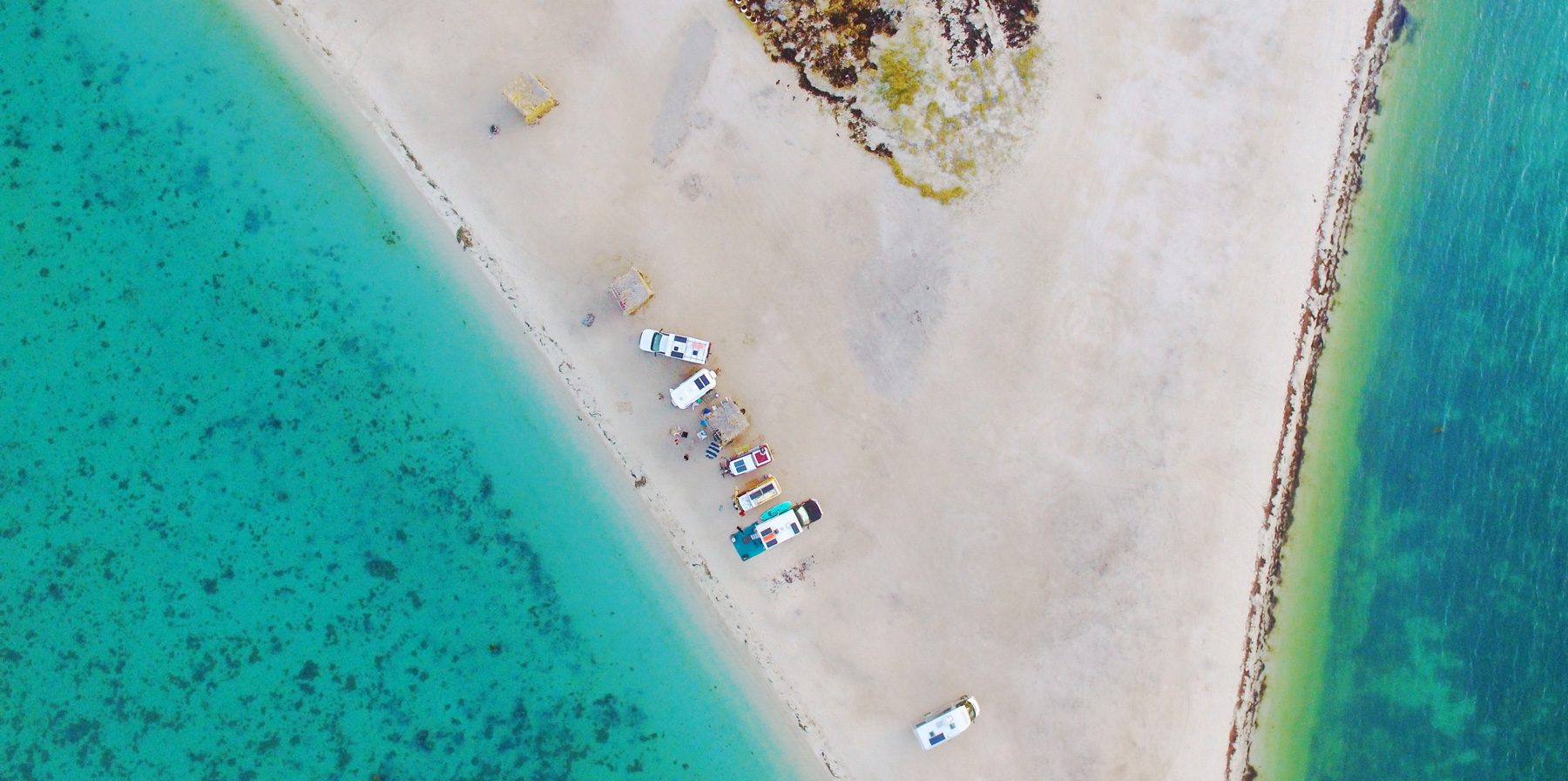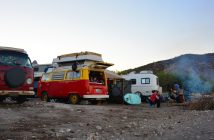Traveling in Baja California, we have encountered a problem we foresaw before we got here. Although we came to Mexico to get to know the locals, we find ourselves primarily hanging out with other gringos like ourselves. Why does this bother us so much, and how will we solve the problem?
One of the themes throughout our trip has been
meeting up with other travelers. You see each other in a parking lot, arrange a date via
Instagram, or start talking to the only other people on your lonely beach. Often you park next to each other, you combine ingredients to make the evening meal, and share your beer when your companions have run out. This leads to some of the most amazing evenings we’ve had on our trip, and connected us with many of the people we have now come to call friends.
We jump at doing this any and every chance we get. Not only does it provide good company and a lovely time, meeting other travelers is one of the best ways to get advice for
living in a vehicle or places you should visit or avoid down the road. It creates a sort of traveler-infrastructure that becomes essential to any sort of travel – it’s very similar to backpacking, in a way. These are the people that are experts in the on-the-road-lifestyle that we are attempting to lead, and meeting up is a way to share that bond, as well as useful information.

Camping with Drive2Ski, Hasta Alaska, and Wanderwasi in El Pescadero, Baja.
A common language and a common culture
But now, coming into Mexico, we have run into a complication – one without an easy solution.
Our entire
trip so far was not in a ‘foreign’ cultural and lingual sphere – in the United States and Canada, we felt more or less at home. In these countries, meeting other travelers usually meant speaking English and sharing cultural traditions that were more or less common to everybody around the campfire. In Mexico, this hasn’t changed. We have met numerous other travelers while traversing the length of Baja. Our common language has been English, and we have shared cultural traditions that we had more or less in common in the first place.
We spent over a week camping with the amazing people from
Bodes.well,
Andrew Knapp’s Mellow crew,
Mali.mish, and
Wanderwasi (all from the US and Canada). We hung around the campfire, enjoyed homemade sangria, and traded travel stories. Both Bodes.well and Mali.mish have children, and have been living as traveler nomads since their kids were babies. They are the vanlife experts, and have had a lot to teach us. We have caravaned with Canadian traveler
WanderGlobe (and his mother) through Baja Sur, enjoyed a wonderful meal with a Canadian expat near Santiago, and camped with
Less Is More from Denmark for two nights in Cabo Pulmo. We also got to meet up with
Hasta Alaska again, who we had met up north in Alaska. The point is: we’ve spent a lot of time with other
gringos* on Baja.

We spent almost a week camping with Bodes.well, Wanderwasi, Mali.mish, and Andrew Knapp near Loreto and Mulege.
This is not why we came to Mexico
But, was it our intention to come to Mexico to socialize almost exclusively with other
gringos? Wasn’t the point to get to know Mexicans,
learn their language and traditions? Have we really experienced Baja like we meant to, if we barely get to know a single local? Sure, we’ve
talked to locals whenever we can, and Sven took up an invitation to fish with a local for the morning in Baja Norte. But these have been limited to conversations, moments, single pictures. We haven’t
camped with any Mexicans, sat with them drinking tequila around a campfire and traded travel stories, understood how
they understand Baja. No, instead, somehow, we’ve stuck to our own, battled the foreign country of Mexico from the outsider’s perspective, wondered at it with other
gringos from the outside looking in. This is not why we came to Mexico.

Is camping alone preferable instead?
This has left us feeling unsatisfied. So should our goal, instead, be to avoid other gringo travelers completely? Would it serve our purpose better to say we will only attempt to meet locals, that we should choose between camping with Latinos or alone altogether?
Baja, the peninsula of gringos
Of course, this would not be a practical solution. Baja, a land of nearly empty deserts and isolated beaches, is a major destination for tourists and overlanders from other parts of North America, as well as most of us traveling along the
Panamerican Highway. For the amount of space on this peninsula, there are just not that many locals to fill it. Even if we wanted to, we couldn’t avoid running into other travelers, as they seem to be often the only other guests camping on our beach. And of course,
when we see a bus like Mellow, we
will stop and say hi – an interaction that often leads to the next campground anyways. Especially in the south of Baja,
gringos, travelers, and expats seem to be everywhere, signs are often in English, and one can probably get by on next to no Spanish. On Baja, we will not be able to avoid socializing with
gringos.

Exploring Mulege in the company of our gringo friends. Together we discover the town from an outsider’s perspective.
This was one of the fears we had when we were reviewing our expectations about vanlife and our trip south of the Mexican-American border. We knew we would meet a lot of other travelers, and that nearly all of them would be from North America or Europe. We also knew that we would never say no to a campout with such like-minded souls – that’s just not how we roll. And we knew that, as awesome as the campout might be, this would lead to frustration about just brushing the surface of Mexican society and foster none of our language skills. Just as we had feared, we find ourselves in a conundrum.
How to solve the problem?
So how should we go about solving our problem? Avoiding other gringo travelers is not the solution, and completely impractical while traveling on Baja. We hope that things will change on the mainland – we’ve heard from other travelers that there is a lot less tourism and a lot less empty space. In addition to this, there are different roads and routes throughout all of mainland Mexico; unlike Baja, which acts like a funnel for travelers, because there is only a single highway for most of the peninsula. Maybe it will be easier to meet locals, and maybe we will not simply run into gringo travelers as often as we do now once we take the ferry to Mazatlán on the Mexican mainland.
We can also employ one of the best ways to meet locals – the social platform
Couchsurfing, a social network for travelers looking for a free place to stay and locals to show them the ropes. Although this is one of our favorite strategies for meeting locals, towns on Baja have often been too small to take advantage of this, and free camping has been available everywhere. As our Spanish improves, we will also be able to strike up more conversations with people we tend to meet on the street or in the supermarket – another valuable resource for getting to the heart of a place. Local VW communities – we’ve heard they’re numerous in Mexico – will also be a chance for us to do what we do, Latino-style.
Balance, as always, will be the key

Camping in Cabo Pulmo with Wanderglobe and Less Is More.
As with everything in life, too much of a good thing is not always a good thing. The key to solving our gringo conundrum will be finding a balance between the two worlds. We will not, and should not, give up meeting other travelers from cultures similar to our own. Even if we are probably not speaking Spanish during such encounters, we are taking advantage of an essential resource: the knowledge and infrastructure of the traveler community. We are also meeting incredible people, as most travelers tend to be, who we will continue to share beers with around a common campfire.
These are bonds that should not be condemned or sacrificed for the sake of soaking up Mexico. On the other hand, we cannot, and should never, forget to soak up as much of Latin America and its language as we can. After all, isn’t that why we came here in the first place?
*A note on the use of the term gringo in this article: Gringo is the generally accepted word in the Latino world for “non-Latino person”. Upon discussion of the topic with a local from Todos Santos, Baja, he insisted that gringo specifically describes someone who is white (although he differentiated that if a Latino looked white, they would not be considered a gringo). He also considered those of Spanish nationality not to be gringos. We use the term here to distinguish between foreigners and those of Central- or South American origin, which, for us, showcases differences not so much of physical but rather of a cultural and lingual nature.










